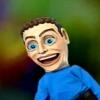-
Posts
145 -
Joined
-
Last visited
-
Days Won
1
ChronA last won the day on January 20
ChronA had the most liked content!
Reputation
120 ExcellentProfile Information
-
Gender
Male
-
Location
Northern Virginia, USA
-
Interests
Narrative Craft, Science Fiction, Game Modding
Recent Profile Visitors
10586 profile views
-
Uh... A suffering protagonist is kind of core to the whole Thief narrative formula. Observe: Garrett starts as a starving street urchin, then graduates to professional freelance burglar struggling to pay his rent while every guard, warden, guild thief, and hammerite in the city is gunning for him. It finally looks like he is going to catch his big break if he can just complete a series of harrowing, supernaturally charged heists. Then surprise! His patrons transform into a couple of eldritch demons and rip his eye out of his head! Congratulations, guy who just wanted to get rich and retire, despite your severe injury, you get to go into literal hell and save the world pro bono. Aren't you having fun yet? (And yes for the slow people in the audience, you are having lots of fun, but the character isn't. And the fact this hyper-competent character is clearly struggling in this situation is part of what makes you feel like such a badass roleplaying him.) Shall we continue to games two and three? And for the record, in this case it is not even about being a Mary Sue; because Garrett IS a huge Mary Sue. It's about having a story with character motivations and conflicts. Changing the sex of the protagonist doesn't change the fundamentals of good narrative. Honestly I feel like the real misogyny is that as soon as a woman is put in a life threatening situation and doesn't act like it's a lovely walk in the park, some people get a reflexive ick reaction. But what do I know? It's not like I've been spending the last several years of my free time writing a mythological fantasy novel starring a (completely non-eroticized) young female protagonist, and agonizing over how to calibrate the amount of danger she is exposed to and her reactions to it. That would be crazy.
-
I think this has some promising signals. For one thing let's acknowledge that, after the Thief 4 reboot failure, it can't have been easy to get this thing made. The first reboot was a studio mandate project, clearly designed by a committee of brainless marketing execs to chase the proven Deus Ex HR buyer market. But who is the target market for this game? The legion of VR equipped Thief fanatics--all ten of them? No. This looks to me like it could be someone's passion project that somehow bubbled up through the studio system. Notice also that this one is far more naratively daring than 4. Firstly they are not trying to gaslight us with a fake Garrett. Instead they are actually trying to do a woman apprentice as teased by the ending of Deadly Shadows. Secondly, while it's easy to joke about Garrett becoming The Eye, that is actually a really interesting way of renewing the cycle. In the original trilogy The Eye was an enigma. It had no real explanation in either of its appearances. By transmuting the old protagonist into the new equivalent of that enigma, all the events of the previous games become legendary, and that lends the new story an opportunity for mythological gravitas that Theif 4 never had. Does that mean I expect it to be good? Hell no! The record for recent female led soft reboots of male led franchises is terrible. And making good stealth games is hard at the best of times. But there is the possibility. It seems like they are trying to learn from the sins of Thief 4. If they can thread the needle with the new protagonist, making her genuinely suffer and struggle without becoming pathetic, and get the gameplay right... Maybe.
-
The responsible thing would be to consult an IP lawyer in your jurisdiction first. Ultimately there is always a certain degree of risk any time you build off someone else's intellectual labor. Who if anyone actually can exercise property rights over information cannot be definitely answered except in a court room, because at the end of the day it's all just a bunch of arbitrary and fuzzy labels being incompetently rationalized by halfwit bipedal apes.
-
I think this is as it should be. I have been vocal in my support for Hazard Pay's and in preaching the value of respect for authorial intent. However I'm also a big believer in the freedom to modify software however you want. In my opinion, installing mods is like leaving the designated trails in a national park. It should be understood that by doing so you are taking full responsibility for your experience into your own hands. If you have a sub-optimal time, that's your own fault. This could be a very valuable tool for people who want to experience TDM a certain way (authorial intent be damned) and it would be a shame to risk neutering it for the sake of a few edge cases.
-
It's never a problem, until when one day it is a problem. That said, maybe this is a disease where continuous preventative treatment is worse than a targeted remedy after infection. I'm reminded of an incident I saw in the 0AD RTS project's community where someone (possibly as a troll, but maybe genuinely) complained about "immodest outfits" worn by female villagers and hero units for some of the civilizations being in breach of the project's content and exclusivity guidelines. The tremendous irony was that the bikini tops on those character models were already a concession to modesty, considering the historical reference art they were modeled from were even less covered up. Any rule set is going to contain oversights and ambiguities that trolls can exploit.
-
By the way, the blog "A Collection of Unmitigated Pedantry" by Dr. Bret Devereaux is a great resource for accessible information about historical armor and warfare generally. As it happens, his most recent post critiquing sci-fi armor in movies and video games gives a good primer on historical armor design in general. Of course, it should go without saying that just because historically things were done a certain way does not mean that artists need to follow suit. But it can be helpful to understand the practical logic behind the traditional iconography of armor in so far at that informs modern expectations. The linked post is also interesting in providing some insight into how practical requirements for real ballistic armor and film costumes have skewed the popular understanding of how armors should look. (Lastly I would be remiss not to recommend Bret's stunning dissections of the battles in The Lord of the Rings -- examining every level of the action in both the books and movies from the perspective of a historian of warfare (starting here).)
- 136 replies
-
- polished metal
- shiny metal
-
(and 2 more)
Tagged with:
-
My vote would be for a new armor set using #2, or maybe blend between #1 and #2; the guy with the breastplate looks good at #3, and #4 looks good on the guy on the left with the shoulder plates. I think that would give a appropriate progression of ostentation, without any of the armor sets subverting the implication of pervasive decay that characterizes the TDM aesthetic. Addendum: IMO #4 is definitely too shabby for the breastplate set. At that level of grungyness I feel like we should be seeing more rust spots and pitting on the face of the breastplate, and the fact that they are not there makes it look like a painted prop rather than actual steel. The texture work for #4 on the gorget and spaulders of the guard on the left do it right.
- 136 replies
-
- polished metal
- shiny metal
-
(and 2 more)
Tagged with:
-
Just out of curiosity, do you have something specific in mind? Maybe a different helmet? To my eyes the guy with the visible breast plate and cage helmet is just about at the right level of gear where you would expect a refined finish, and also at the point where adding more armor doesn't make much sense for daily guard duty. In fact, I'd even say gauntlets might be overkill. For example, look at what the Swiss guard wear: As a rule with plate armor, the further you go from the head and torso the more you get diminishing returns for both protection and practicality; even if admittedly gauntlets and grieves do look super cool.
- 136 replies
-
- 1
-

-
- polished metal
- shiny metal
-
(and 2 more)
Tagged with:
-
Armor rusts, and the more you ignore the rust the faster the rust spreads. (Corrosion reactions scale with surface area, which is increased by rust flakes and scratches. A mirror polish minimizes surface area.) So if you neglected your armor so that it looked like those Fromsoft references, you would be buying a new suit of armor within a few years, and suddenly that captain-of-the-guard salary would be stretched pretty thin. Plus your employer would probably fire you for making him look like some pitiful hobo who hired a bandit to guard his house instead of a proper man-at-arms! So yes, in a realistic setting, an elite guard like that would probably have armor that is polished to a mirror finish, because part of his job is in fact to care for his armor. That would include making sure that it is immaculately oiled and polished before putting it on. That said, TDM is a fantasy game, and it's important to have a cohesive aesthetic to communicate the themes of the setting. One of the most common of those themes is the depravity and corruption of elites, and an easy way to communicate that visually is to put a thick layer of tarnish and grime on all their shiny trinkets. In contrast, to modern eyes mirror polished armor communicates vanity, grandiosity, and egomania, but not necessarily depravity. In that sense I agree that the new model should be a separate variant rather than replacing the default, so that FM authors can be intentional about how they use it.
- 136 replies
-
- 2
-

-
- polished metal
- shiny metal
-
(and 2 more)
Tagged with:
-
When I get that mood I go into no-clip + no-detect and fly around the map, sight seeing.
-
I don't think I've seen that. Now I'm curious.
-
I don't like using the blackjack. To me it's feels as artless as running around slaughtering everyone on the map from the shadows with your sword. Mechanically there is no difference at all between the two, and for role play I can't really buy into the fantasy that the blackjack is supposed to invoke. In the real world getting cranially bludgeoned with a sack of lead on a stick will absolutely kill you dead, nearly as surely as getting stabbed or shot with a low power arrow in the same location. (Real talk: if you bludgeon 7 or 8 guards during a mission, chances are more than one of them is not waking up after the mission is over, no matter what your score screen says!) Gas arrows I like better. It's a fun puzzle trying to optimize the usage of those precious few arrows for maximum effect. It's also easier for me to suspend my disbelief in magic sleep gas than in magically physics and biology altering cudgels. Consequently most of the time I do end up playing a pretty ghost-like style. I think leaving conscious enemies behind also makes the game more fun for backtracking. I do save quite frequently, pretty much every few minutes, or every time I reach a particularly safe seeming spot. This just seems prudent to avoid huge loss of progress if I die or the game bugs out or crashes. However, I try not to ever reload unless absolutely forced to. Additionally I try to play with a rule that if I do reload because of an avoidable skill-failing on my part, I must discard some sort of rare resource that I will miss, like a special arrow or a health potion. Thus, to conserve resources, I almost always try to play the escape after I get caught. Admittedly, in such circumstances I tend to panic, so my survival rate is not always great, but I have had a few really thrilling escapes that remain quite memorable. This system keeps me from deliberately scumming most of the time. However, it's tricky because I feel like quite a few missions are balanced around the assumption that players will save scum, and therefore need to be challenging even taking that remarkable power into account. Consequently they are not balanced such that one can go discarding resources each time something goes wrong! This is discouraging, and there have been a few very high quality missions where I regrettably lost interest because I ran out of expendable consumables to drop after so many irrecoverable accidents.
-
@Sotha Okay, so you are looking for a means to materially incentivize no-KO and no-kill, without a hard loss condition, and without majorly increased production work. Also I assume you don't want gamy-nonsense like just instantly alerting everyone in the area when the deed is done, regardless of the lack of witnesses. Fair enough. How about this then? Split your map into two or more areas. Then have a trigger so that when the player breaks the optional objectives, the alert level increases in all the areas except the one that the player is in. Lastly have a trigger so that when the player leaves the area where they did the deed, the alert level in the area they left behind is increased (perhaps even more than the other areas). This could simulate the idea that the person you eliminated failed to check in or something like that, and it caused an alert to be raised, without massively increasing the complexity of the scripting or requiring custom assets. You could also take this concept even further by de-spawning some easy to grab loot at respawing it in a more secure location at the same time the alerts are triggered. Locking up the valuables is a reasonable response when something is amiss.
-
The classiest solution could be to have alternate endings. For example, one could reward the player if they successfully completed optional no-kill and no-KO objectives with an extra bit of bonus dialog or a cut scene at the end of the mission. In a multi-mission campaign you could also alter subsequent levels with more alert guards or chatter about a killer on the loose. Obviously that would take some extra work for the mission author to implement, so I don't mean to suggest it as a prescriptive solution. But for those with the means, it would make an ideal compromise between the vision of the author and the freedom of the player.
-
I'll make a prediction: as with the human genome project discovering that most of the human genome is made of low or non-functioning "junk" DNA, I suspect these brain maps will reveal that most of the connections in the human brain are random junk, and the minimum necessary neural graph needed to sustain human level cognition is actually embarrassingly small. There's some biological precedent for this. Evolutionary selection for lean, efficient brains is actually pretty rare in nature, but where it does occur it usually gets results without sacrificing behavioral complexity. There are humming birds the size of insects, and wasps the size of micro-organisms, that somehow still manage to act like their big counterparts. Humans are a new species in a new niche, and it's likely that we have never experienced selection for neural efficiency, unless that happened to be one of the prerequisites for evolving our intelligence, but that's just unsupported supposition. The other evidence that our brains are still in the messy prototype stage of their evolution is that LLMs have already managed to generate some very human-like emergent cognitive behaviors, using comparatively very lean neural networks that ought to be mostly dedicated to linguistic symbol arithmetic. That's why I no longer believe bio-mimetic neural-architecture to be a hard technological prerequisite for AGI (after years of holding that position).









